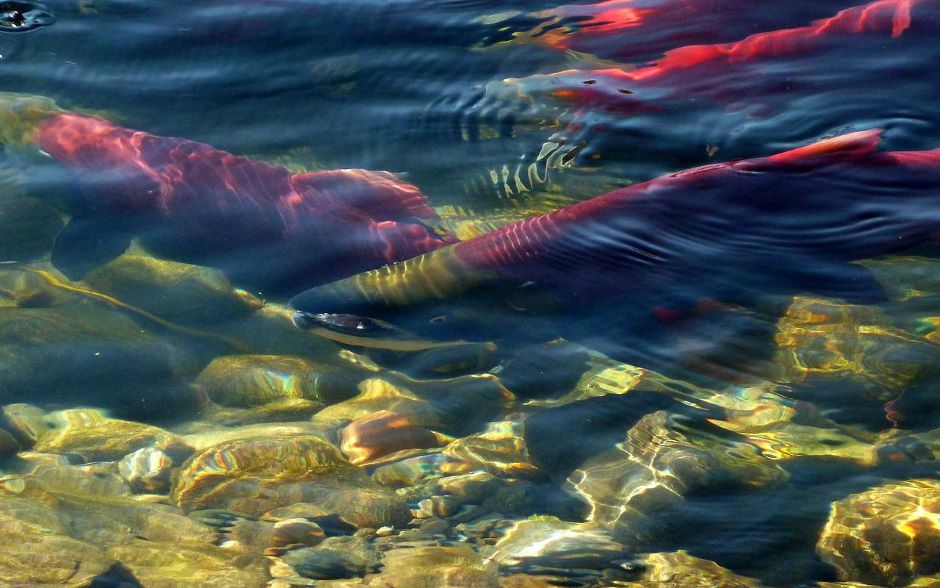Vanishing Sockeye Salmon in Washington
 (Credit: Brigitte Werner from Pixabay)
(Credit: Brigitte Werner from Pixabay)In 2021, sockeye salmon numbers were at an all-time low, reports My Ballard. Numbers have been steadily declining for the better part of 2 decades. Then, at the end of 2020, data confirming that the prized fish weren’t returning in the same numbers as before emerged.
For example, one river looked at was the Cedar River in Washington State. 22,950 salmon were counted at the Ballard Locks Fish Ladder during migration in 2020. Unfortunately, only 3,000 salmon returned to the Cedar River and half of the returnees are expected to die before reproducing.
Lake Washington Salmon
Lake Washington was once a popular catch site for sockeye salmon, and anglers, young and old, frequented the lake every summer when the sockeye seasons occurred. According to Leschi Community Council, Lake Washington only has a season when at least 350,000 sockeye are predicted to enter the lake.
The return drop-off began in 2006 when 453,543 fish returned to the lake. Since that year, the population has continued to decline, and each year, fewer salmon return to the lake. Each year sets a new record low, and anglers, locals, and researchers are left asking why.
Fishing in Washington Lake used to be lively and active. Anglers would travel from across the county to catch sockeye, and locals would have their summer activities set. However, fishing in the lake hasn’t been the same since 2006. And, due to population declines, there haven’t been any Lake Washington sockeye fisheries in recent years.
Missing Sockeye Salmon
There is no single factor that led to sockeye going missing in Washington. Instead, experts propose that several environmental stressors led the fish to vanish. Two of the most significant factors are invasive species eating salmon smolts, thus lowering the reproductive capabilities of the species and increasingly warmer waters.
“Warmer water temperatures weaken salmon and make them more susceptible to disease, particularly returning adults,” reports the Leschi Community Council. While some casualties are expected during the routine salmon runs, the number of salmon heading out for migration was smaller than usual in 2014. Unfortunately, the decline in migrating fish means that fish are not surviving in their home territory, and warming waters are a likely culprit.
Increasing light pollution and the invasion of predatory fish like walleye or pikes have made Lake Washington less hospitable for sockeye salmon. Some conservationists believe that replenishing sockeye in the lake is an impossible task. Unfortunately, increasing water temperatures and predatory species populations mean the ecosystem simply doesn’t support sockeye salmon anymore.
Local Salmon at Risk
More than just sockeye have seen declines in the past few decades. Kokanee, steelhead, chinook, and other native fish have been declining for a long time now. Sockeye have managed to garner the most attention because they have some of the steepest declines and used to be abundant throughout Washington.
Local populations are thrown off balance by the disappearance of salmon as much as the lake and river ecosystems. Indigenous groups that historically relied on fish for food are facing new insecurities due to the vanishing sockeye.
In an interview with the Seattle Times, Donny Stevens, Vice-Chair for the Muckleshoot Indian Tribe Council, stated, “In a generation we have gone from times of plenty, to these fish being on the brink of extinction.” Stevenson went on to say, “Our people have been here for thousands of years, hundreds of generations. We have found a way to exist in this environment. This is about balance.”
Conclusion
Though some critics believe restoring salmon populations to their earlier levels is impossible, researchers and activist groups have not given up hope. The Muckleshoot Tribe and the Washington Department of Fish and Wildlife have partnered together to see if holding the smolt in an upstream hatchery longer will lead to a stronger population.
Stronger smolt stand a better chance of reaching adulthood once they are stocked in Washington Lake and other surrounding bodies of water. The road to recovery is long and will take the continued work and effort of activist groups. In the same interview with the Seattle Times, the chairman of the Muckleshoot Indian Tribe states, “The salmon can’t speak, and they need someone to speak for them, and protect them.”



Pingback: FishSens Magazine | Protecting Bristol Bay Salmon from Mining - FishSens Magazine
Pingback: FishSens Magazine | Building Salmon Knowledge In Alaska - FishSens Magazine
Pingback: FishSens Magazine | The Future is Seafood - FishSens Magazine
Pingback: FishSens Magazine | Stopping the Spread of Asian Carp - FishSens Magazine
Adolphus Gustave
October 11, 2022 at 4:20 pm
Its a very good information for every fish lover
Pingback: FishSens Magazine | How Low Can Fish Go? Diving Deeper to Beat the Heat - FishSens Magazine
Pingback: FishSens Magazine | Stopping the Spread of Asian Carp - FishSens Magazine
Pingback: FishSens Magazine | Climate Change Altering Fish Distributions - FishSens Magazine